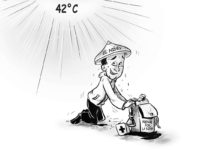[av_one_full first min_height=” vertical_alignment=” space=” custom_margin=” margin=’0px’ padding=’0px’ border=” border_color=” radius=’0px’ background_color=” src=” background_position=’top left’ background_repeat=’no-repeat’ animation=”]
[av_heading heading=’Climate change needs social change’ tag=’h3′ style=’blockquote modern-quote’ size=” subheading_active=’subheading_below’ subheading_size=’15’ padding=’10’ color=” custom_font=” av-medium-font-size-title=” av-small-font-size-title=” av-mini-font-size-title=” av-medium-font-size=” av-small-font-size=” av-mini-font-size=” admin_preview_bg=”]
BY IKE SEÑERES
[/av_heading]
[av_textblock size=” font_color=” color=” av-medium-font-size=” av-small-font-size=” av-mini-font-size=” admin_preview_bg=”]
January 18, 2018
[/av_textblock]
[av_textblock size=” font_color=” color=” av-medium-font-size=” av-small-font-size=” av-mini-font-size=” admin_preview_bg=”]
IF IT IS human wrongdoing that has caused climate change, then society has to change in order to correct what was done wrong. It is as simple as that.
As it is now, it appears that the damage that was caused by human wrongdoing is not reversible. That is why no one is talking about climate repair, because all that we could do now is to adapt to climate change, hence the concept of climate change adaptation (CCA).
Be that as it may, there is still hope for neutralization, meaning to say that the damage could still be contained, so that it will no longer worsen. And if we get lucky, we may even lessen the damage to a point where the threat to human security will be lesser. Meanwhile, we have no choice but to expect disasters to happen, hence the concept of disaster risk reduction (DRR).
An eye for an eye, a tooth for a tooth – that should be our attitude towards CCA. Tit for tat – as intensely as we committed the wrongdoing (even as we still continue to do wrong), we should become more intense in doing right to make good in CCA, with so much energy that could hopefully bring us to the point of neutralization.
What I mean by intense is not necessarily in terms of warp speed, because it did not take us one day to destroy our climate. It also need not be in terms of big volumes, because it took small pieces of plastic to clog our waterways. In theory, if we clean our waterways one droplet at a time, all of it could become cleaner at some point in time.
Without any doubt, it is our lifestyle that triggers the production of carbon dioxides that destroy our atmosphere. Conversely, it could also be our lifestyle that will cause the production of oxygen that will neutralize the carbons.
That may seem like a simple case of mathematics, to replace subtraction with addition, but it seems that we are going to need lots of multiplication to make that happen. The problem with our lifestyle is that it is so deeply engrained in our daily lives, so much so that it is really very difficult to imagine our lives without carbons and pollutants, and even without the beef that comes from the cattle that also pollutes the atmosphere.
What is really ironic is that our style of sustaining our life could actually be the cause of the death of our planet and every life form that lives on it, perhaps even during this lifetime of ours. Tit for tat – it is our way of life that could lead to our death, and I do not mean figuratively.
Perhaps to continue with this parallelism, it should be our present way of life that should die, so that we could continue to live. Otherwise, we are going to end up in the wrong side of the mathematical equation – gaining the enjoyment of life, wrong as it is, but in the end losing the life that we would have wanted to last longer.
Tit for tat – since it is technology or the offspring of technology that brought about the changes in our climate; it should also be the offspring of technology that should provide the solutions to the problem. However, since it is public policy that drives the utilization of technology – that is the best place for us to start – to define our public policy so that the remedial technologies could prosper.
Since we are the ones who caused this problem, we should also be the ones to cause the changes of public policy so that the problem could be solved.
We may not know what to do exactly, but we do know exactly where to start – with public policy that is the key to all our societal actions. Since social change is needed to adapt to climate change, we should start by changing the public policies that have either caused the problems or have tolerated it one way or the other.
Of course, it is one thing to change public policies, it is another to change the ways of the people who are obliged to abide by the policy changes. This is where the mass media could come in, considering that media has the capability not only to inform, but to persuade its audiences.
Public policies are merely words that are not worth the paper it is printed on, not unless the people for whom these policies are made for would embrace and own the reasons for their creation. You get what you pay, and conversely you do not get what you do not pay for.
If we do not pay for the neutralization of climate change with our own changes in our social life, then we are ultimately going to pay for the price of not doing it, and you know what that could be./PN
[/av_textblock]
[/av_one_full]



